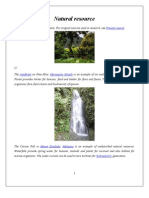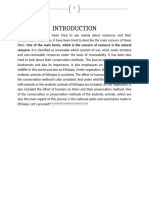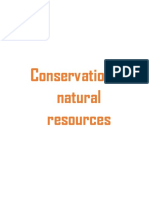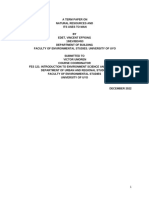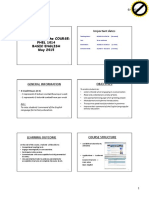2 Natural Resources
2 Natural Resources
Uploaded by
jadoonzCopyright:
Available Formats
2 Natural Resources
2 Natural Resources
Uploaded by
jadoonzCopyright
Available Formats
Share this document
Did you find this document useful?
Is this content inappropriate?
Copyright:
Available Formats
2 Natural Resources
2 Natural Resources
Uploaded by
jadoonzCopyright:
Available Formats
Natural resources any part of the environment that exists and may be used economically for the benefit
of mankind is known as Natural Resource. Such a material exists relatively undisturbed by mankind so far, in a natural form. The term is defined by the United States Geological Survey as "The Nation's natural resources include its minerals, energy, land, water, and biota." Natural resources are derived from the environment. Many of them are essential for our survival while others are used for satisfying our needs. Natural resources may be further classified in different ways. One of most understandable classification is their division on the basis of factors i.e. Biotic and a-biotic. Biotic - Biotic resources are the ones which are obtained from the biosphere. Forests and their products, animals, birds and their products, fish and other marine organisms are important examples. Minerals such as coal and petroleum are also included in this category because they were formed from decayed organic matter. Abiotic - Abiotic resources comprise of non-living things. Examples include land, air, water and minerals such as gold, iron, copper, silver etc. Considering their stage of development, natural resources may be referred to in the following ways: Potential Resources - Potential resources are those which exist in a region and may be used in the future. For example, mineral oil may exist in many parts of Pakistan having sedimentary rocks but till the time it is actually drilled out and put into use, it remains a potential resource. Actual Resources are those which have been surveyed, their quantity and quality determined and are being used in present times. For example, the petroleum and the natural gas which is obtained from any oil field. The development of an actual resource, such as wood processing depends upon the technology available and the cost involved. That part of the actual resource which can be developed profitably with available technology is called a reserve. With respect to renew-ability, natural resources can be categorized as follows: Renewable Resources - Renewable resources are the ones which can be replenished or reproduced easily. Some of them, like sunlight, air, wind, water etc., are continuously available and their quantity is not affected by human consumption. Many renewable resources can be depleted by human use, but may also be replenished, thus maintaining a flow. Some of these, like agricultural crops, take a short time for renewal; others, like water, take a comparatively longer time, while still others, like forests, take even longer. Non-renewable Resources - Non-renewable resources are formed over very long geological periods. Minerals and fossils are included in this category. Since their rate of formation is extremely slow, they cannot be replenished once they get depleted. Out of these, the metallic minerals can be re-used by recycling them. But coal and petroleum cannot be recycled.
Examples
Some examples of natural resources include the following: AgricultureAgronomy is the science and technology of using plants for food, fuel, feed, and fiber, Air, wind and atmosphere, Plants / Flora, Animals / Fauna,
Wildlife, Coal and Fossil fuels, Forestry & Agroforestry Range and Pasture Soils Water, Oceans, Lakes and Rivers
Management
Natural resource management is a discipline in the management of natural resources such as land, water, soil, plants and animals, with a particular focus on how management affects the quality of life for both present and future generations. Natural resource management is interrelated with the concept of sustainable development, a principle which forms a basis for land management and environmental governance throughout the world. In contrast to the policy emphasis of urban planning and the broader concept of Environmental management, Natural resource management specifically focuses on a scientific and technical understanding of resources and ecology and the life-supporting capacity of those resources.
Depletion
In recent years, the depletion of natural resources and attempts to move to sustainable development have been a major focus of development agencies. This is of particular concern in rainforest regions, which hold most of the Earth's natural biodiversity irreplaceable genetic natural capital. Conservation of natural resources is the major focus of natural capitalism, environmentalism, the ecology movement, and green politics. Some view this depletion as a major source of social unrest and conflicts in developing nations. Mining, petroleum extraction, fishing, hunting, and forestry are generally considered natural-resource industries. Agriculture is considered a man-made resource.
Protection
Environmental protection Conservation biology is the scientific study of the nature and status of Earth's biodiversity with the aim of protecting species, their habitats, and ecosystems from excessive rates of extinction. It is an interdisciplinary subject drawing on sciences, economics, and the practice of natural resource management. The term conservation biology was introduced as the title of a conference held University of California at San Diego in La Jolla, California in 1978 organized by biologists Bruce Wilcox and Michael Soul. Habitat conservation is a land management practice that seeks to conserve, protect and restore, habitat areas for wild plants and animals, especially conservation reliant species, and prevent their extinction, fragmentation or reduction in range. It is a priority of many groups that cannot be easily characterized in terms of any one ideology.
You might also like
- Solution Manual Fundamentals of Physics 12th Edition by Halliday and ResnickDocument23 pagesSolution Manual Fundamentals of Physics 12th Edition by Halliday and Resnickhallidayphysics176No ratings yet
- Melfa Basic IV InstruccionesDocument2 pagesMelfa Basic IV InstruccionesEnzo Karol VelásquezNo ratings yet
- Silica Gel Production Report PDFDocument8 pagesSilica Gel Production Report PDFChoice Organo0% (1)
- 5 - Natural ResourcesDocument7 pages5 - Natural ResourcesMustahsan AbbasiNo ratings yet
- Topic 3 Natural Resources Types Uses and AbusesDocument9 pagesTopic 3 Natural Resources Types Uses and AbusesShreyansh JalonhaNo ratings yet
- My Report On Natural ResoursesDocument37 pagesMy Report On Natural ResoursesRavi NegiNo ratings yet
- Natural Resource NewDocument15 pagesNatural Resource NewSOHEL BANGINo ratings yet
- Tugas UmiDocument6 pagesTugas UmimzaluffyNo ratings yet
- Conserving Natural ResourcesDocument14 pagesConserving Natural ResourcesAnonymous y3R5VX1Y8ZNo ratings yet
- Natural ResourceDocument16 pagesNatural ResourceShrikant IngleNo ratings yet
- ARM 205 DigitizedDocument55 pagesARM 205 DigitizedPegNo ratings yet
- Introduction To Forest and Wildlife ManagementDocument14 pagesIntroduction To Forest and Wildlife Managementgolden abidemNo ratings yet
- Natural ResourceDocument16 pagesNatural ResourceMarathi DhinganaNo ratings yet
- Natural ResourcesDocument9 pagesNatural ResourcesPradip TripuraNo ratings yet
- AgEcon479 PDFDocument24 pagesAgEcon479 PDFMehadi HassanNo ratings yet
- Bio Journal RealDocument35 pagesBio Journal Realarmongirma91No ratings yet
- Natural ResourcesDocument3 pagesNatural ResourcesSatyamNo ratings yet
- Finals Lesson 1 Envi SciDocument24 pagesFinals Lesson 1 Envi SciGie Apilado RanayNo ratings yet
- Minor EvsDocument6 pagesMinor EvsMr UdhayNo ratings yet
- Natural ResourcesDocument11 pagesNatural ResourcesBhavesh BhoeeNo ratings yet
- Natural ResourcesDocument6 pagesNatural Resourcesjamieanne242No ratings yet
- Conservation of Natural ResourcesDocument24 pagesConservation of Natural Resourcesmcheche1293% (14)
- Classification of Natural ResourcesDocument24 pagesClassification of Natural ResourcesMillicent NdanuNo ratings yet
- Natural ResourcesDocument3 pagesNatural ResourcesAdityaMohanNo ratings yet
- Natural Resource ConservationDocument20 pagesNatural Resource ConservationBIKRAM KUMAR BEHERANo ratings yet
- Natural ResourcesDocument15 pagesNatural ResourcesSuryaSagarNo ratings yet
- Full Principles and Approaches To Natural Resources ManagementDocument73 pagesFull Principles and Approaches To Natural Resources Managementzuberi hamzaNo ratings yet
- Short Notes On Types of Natural ResourcesDocument7 pagesShort Notes On Types of Natural ResourcesSaurabh SatsangiNo ratings yet
- Natural ResourcesDocument12 pagesNatural ResourcesDiana Fe C. FilpinoNo ratings yet
- Emt 301Document140 pagesEmt 301Aredokun FunmilayoNo ratings yet
- Natural Resources Management and EnvironmantDocument17 pagesNatural Resources Management and Environmantlamiamumtaz76No ratings yet
- Natural Resource Management Law - NoteDocument8 pagesNatural Resource Management Law - NoteDinberu GetachewNo ratings yet
- Mother Fuc Fake WebpageDocument66 pagesMother Fuc Fake WebpagemoviesandcartoontamilexplainchNo ratings yet
- Philippine Natural Resources Report (3) - 020629Document14 pagesPhilippine Natural Resources Report (3) - 020629Al Gester CudalNo ratings yet
- Earths ResourcespDocument4 pagesEarths ResourcespMohamed WeyimiNo ratings yet
- Natural ResourcesDocument2 pagesNatural ResourcesNancy Barak100% (1)
- Pape2 (Ready To Print)Document10 pagesPape2 (Ready To Print)Khel Agana VisenNo ratings yet
- Fold 3Document13 pagesFold 3pratik.kotechaNo ratings yet
- Natural Resource Management Law - NoteDocument8 pagesNatural Resource Management Law - NoteDinberu GetachewNo ratings yet
- Natural Resources Are Resources That Exist Without Actions of HumankindDocument4 pagesNatural Resources Are Resources That Exist Without Actions of HumankindOOthaNo ratings yet
- Envi Section 1-3 Module 3Document2 pagesEnvi Section 1-3 Module 3mark woo lingNo ratings yet
- Natural ResourcesDocument6 pagesNatural Resourcesdevc5652No ratings yet
- Natural ResourcesDocument5 pagesNatural Resourcesarvidkumar87060No ratings yet
- Natural ResourcesDocument39 pagesNatural ResourcesPratyush IyerNo ratings yet
- Vincent term paperDocument13 pagesVincent term paperVincentNo ratings yet
- Chaprter 2: Environmental ScienceDocument9 pagesChaprter 2: Environmental Sciencejeboy DaquizNo ratings yet
- Chapter-1 EnviSci IntroDocument8 pagesChapter-1 EnviSci IntroJohn Ross EdmaNo ratings yet
- Nat DGGDocument20 pagesNat DGGkumarpraveeengNo ratings yet
- Environmental Science & Disaster ManagementDocument105 pagesEnvironmental Science & Disaster ManagementJyothis T SNo ratings yet
- EC-Unit 1-Lesson 3-Natural Resources-Associate Problems and LawsDocument22 pagesEC-Unit 1-Lesson 3-Natural Resources-Associate Problems and LawsHarshit sharmaNo ratings yet
- Chapter 1Document47 pagesChapter 1johnedward.gerondioNo ratings yet
- 6d7b83 Natural Resources and Associated ProblemDocument3 pages6d7b83 Natural Resources and Associated ProblemAyushi Singh100% (3)
- Constituents of Environment-1Document50 pagesConstituents of Environment-1hfb8t62chbNo ratings yet
- Natural ResourcesDocument4 pagesNatural ResourcessandeepNo ratings yet
- Natural Resource-WPS OfficeDocument2 pagesNatural Resource-WPS OfficeMD ALI100% (1)
- School Year: 2023-2024: English TalkDocument5 pagesSchool Year: 2023-2024: English Talkcarel ZahuiNo ratings yet
- Unit 1 IntroductionDocument38 pagesUnit 1 IntroductionbereketNo ratings yet
- Natural ResourcesDocument32 pagesNatural Resources121923601018No ratings yet
- Chapter 1Document47 pagesChapter 1johnedward.gerondioNo ratings yet
- Non Renewable Energy SourcesDocument50 pagesNon Renewable Energy SourcesKishor PatilNo ratings yet
- Article On Ways To Manage and Exploit Atmospheric ResourcesDocument14 pagesArticle On Ways To Manage and Exploit Atmospheric ResourcesChinenyeNo ratings yet
- Principles of Natural Resources ManagementDocument12 pagesPrinciples of Natural Resources Managementotaala817167% (3)
- Exploring the Ecological Dynamics : Interactions Between Fish and Birds in Aquatic EcosystemsFrom EverandExploring the Ecological Dynamics : Interactions Between Fish and Birds in Aquatic EcosystemsNo ratings yet
- El3356 0010Document3 pagesEl3356 0010Krishnamurthy KulkarniNo ratings yet
- Material Take Off Bulk MTODocument6 pagesMaterial Take Off Bulk MTOJordan MosesNo ratings yet
- Washer Dimensions PDFDocument2 pagesWasher Dimensions PDFTarunNo ratings yet
- Lecture 1Document2 pagesLecture 1Kelvin LeongNo ratings yet
- MSI - 7642v1.0 (G52 76421X1) (890GXM G65) PDFDocument110 pagesMSI - 7642v1.0 (G52 76421X1) (890GXM G65) PDFКирилл КошкинNo ratings yet
- Inventor Pro Detail BrochureDocument29 pagesInventor Pro Detail Brochurememetic_2010No ratings yet
- Indirect Feedback Compensation of CMOS Op-Amps: Vishal Saxena and R. Jacob BakerDocument2 pagesIndirect Feedback Compensation of CMOS Op-Amps: Vishal Saxena and R. Jacob BakerNguyen HienNo ratings yet
- Group Assignment CSR MEC 600 Oct 2017Document5 pagesGroup Assignment CSR MEC 600 Oct 2017zzNo ratings yet
- Topic2 - Influence Lines For Statically Indeterminate BeamsDocument21 pagesTopic2 - Influence Lines For Statically Indeterminate BeamsMary Joanne Capacio AniñonNo ratings yet
- Additivefertigung English PDFDocument76 pagesAdditivefertigung English PDFMayank PatelNo ratings yet
- Recursive Functions: Writing and Tracing A Recursive Function Terminal CaseDocument11 pagesRecursive Functions: Writing and Tracing A Recursive Function Terminal CaseSamiul Alim LesumNo ratings yet
- Exercise 1.3Document4 pagesExercise 1.3rashedalbreiki565No ratings yet
- Lexical Variation in Australian EnglishDocument5 pagesLexical Variation in Australian EnglishSweetjustine QuijanoNo ratings yet
- Class 10 - Physics - Refraction of Light at Plane Surfaces SolutionsDocument68 pagesClass 10 - Physics - Refraction of Light at Plane Surfaces SolutionsAndrik LalNo ratings yet
- Rak College of Nursing, Lajpat Nagar, NEW DELHI 110024Document17 pagesRak College of Nursing, Lajpat Nagar, NEW DELHI 110024Pankaj S R MehrotraNo ratings yet
- UracaDocument20 pagesUracaAldenNo ratings yet
- Research Methodology MCQ's & AnswersDocument37 pagesResearch Methodology MCQ's & AnswersSiqiniseko GumbiNo ratings yet
- 2 2 ETwinning WrittenMediation LearningSequenceDocument5 pages2 2 ETwinning WrittenMediation LearningSequenceTERESANo ratings yet
- FICHA TECNICA EHB04 - Tech - DatasheetDocument5 pagesFICHA TECNICA EHB04 - Tech - DatasheetLio LiverhNo ratings yet
- Example Below - It Will Make Sense Eventually!) - Influence Lines Can Be Obtained For Bending MomentsDocument3 pagesExample Below - It Will Make Sense Eventually!) - Influence Lines Can Be Obtained For Bending MomentsMoise MihaelaNo ratings yet
- Brochure - StatClave 2023Document1 pageBrochure - StatClave 2023SuchetanaNo ratings yet
- CLAS-21st-Century-Literature-Sem1-Week3 - RHEA ANN NAVILLADocument13 pagesCLAS-21st-Century-Literature-Sem1-Week3 - RHEA ANN NAVILLAKrizel Joy EsquiviasNo ratings yet
- Haryana State Team Contact DetailDocument1 pageHaryana State Team Contact DetailAbhiNo ratings yet
- Continuum of Depth of Sedation Definition of General Anesthesia and Levels of Sedation Analgesia PDFDocument2 pagesContinuum of Depth of Sedation Definition of General Anesthesia and Levels of Sedation Analgesia PDFMaria Aurelia PrajitnoNo ratings yet
- Lettuce Narrative ReportDocument6 pagesLettuce Narrative Reportmatthewbianes10No ratings yet
- Lighting ChecklistDocument1 pageLighting ChecklistDanielNo ratings yet
- Women EntrepreneurshipDocument103 pagesWomen EntrepreneurshipShruti Vikram100% (1)












